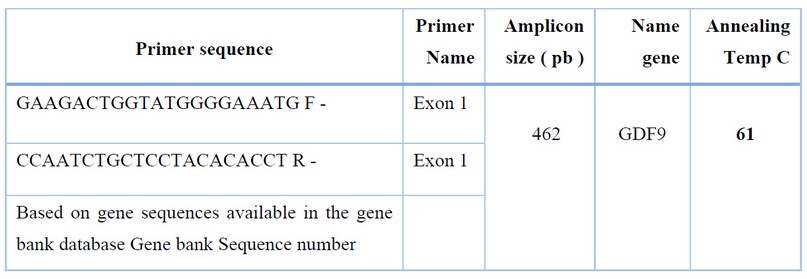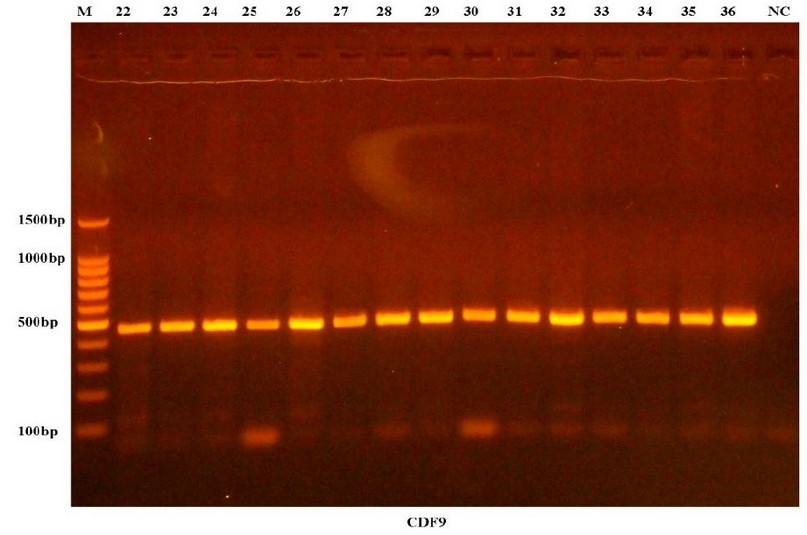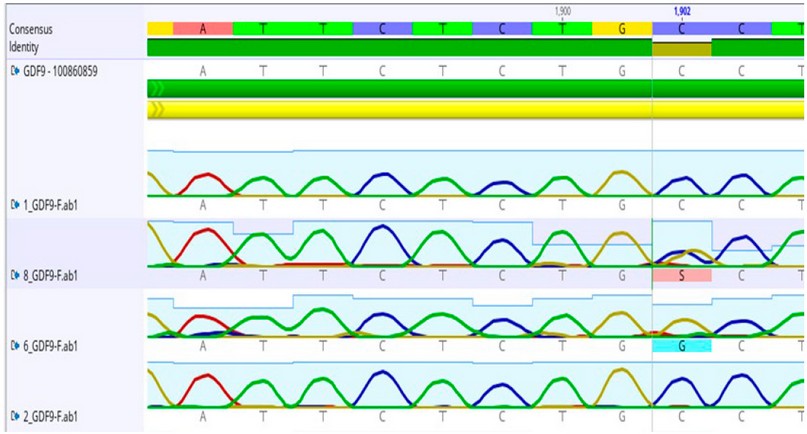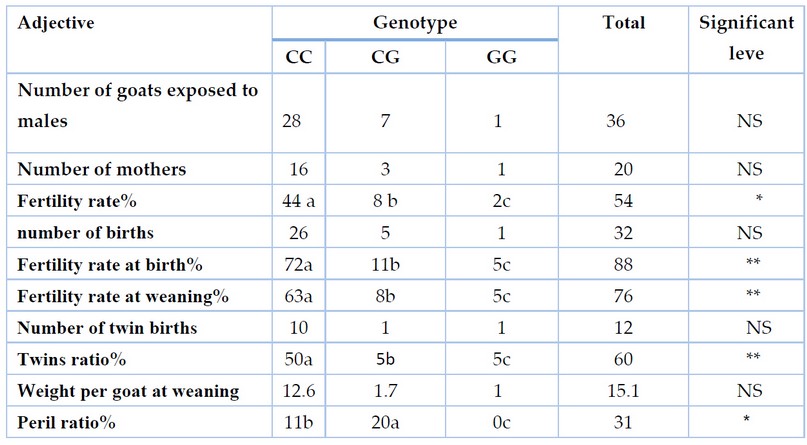Vol 7 No 4 2022- 49

Detection of polymorphism in growth differentiation factor 9 gene (GDF9) Exon1 and its association with litter size in local Iraqi goats
Ola Hussen Ali 1, Salih Hassan Al- Azzawi 2*
1Department of Animal Production – College of Agriculture – University of Diyala. Iraq
*Corresponding author. Agrianmh14a@uodiyala.edu.iq
Available from: http://dx.doi.org/10.21931/RB/2022.07.04.49
ABSTRACT
Litter size is one of the most important economic traits in goats. Growth Differential Factor 9 (GDF9) Gene is suggested as a functional candidate for fertility, fecundity and twining rate. This study was performed to identify SNPs in exon1 of the GDF9 gene and their association with fertility traits in local Iraqi goats. The exon 1 of GDF9 was sequenced, and the SNP (Single nucleotide polymorphism ) was determined in 36 local Iraqi goats. Then the association analyses between polymorphic locals of GDF9 and litter size were performed using the chi-square analysis procedure. The result shows that mutation (C 1902 G) was significantly associated with litter size in local Iraqi goats and the location of C1902 G mutation with three genotypes CC, CG and GG. A significant effect was found for birth weight, weaning weight and twin ratio, where the homozygous dominant genotype outperformed CC. A significant impact was seen for fertility and mortality, where CC topped CG and GG in fertility percentage and superiority of CG over CC and GG in mortality rate. The results preliminarily demonstrated that GDF9 was a critical gene affecting the fecundity of local Iraqi goats and that (C 1902 G) could be a potential genetic marker.
Keywords: GDF9 gene, litter size, polymorphism, Iraqi goats
INTRODUCTION
The interest in improving the production of farm animals, including goats, is very important to increase economic performance. The breeder follows breeding programs to increase the productive capacity of the animal by raising the frequency of good alleles in the herds and making a selection for them, including ovulation rate and size of births in the abdomen can be controlled. 1 One is inherited by several genes with few effects, and sometimes by one gene with significant effects, these genes are called fertility genes2, as these genes in the DNA responsible for the size of the abdomen as well as fertility traits are essential in goats and have value High economic 3 and that the number of births in one ateras is considered a profit factor for educators, as the number of births in one womb depends in particular on the rate of ovulation and there are genes that have an effect on the ovulation rate where GDF9 is a growth factor and a member of the beta-type transforming growth family and it has a crucial role In the reproduction of sheep and goats through the development of the ovarian follicle and the rate of ovulation 4-5And not only in females, it was found to have an influential role in semen quality in male goats 6 ,New molecular genetics techniques enable researchers to use genes of high economic importance found in specific strains to be passed on to other strains 7, in general, the genetic makeup is the one that controls the body structure of the sheep. An organism, through the action of genes, means that the genes in the nucleotide sequence that are loaded on chromosomes in the cell nucleus are the main rulers of the animal’s performance8. The mutation can cause a change in the part or the entire gene that controls traits, and a phenotypic variation occurs in the trait as a result9. The mutation can occur at the level of the gene, causing one or more nitrogenous bases, or appear at the chromosomal level, so they are called chromosomal mutations, which cause a change in chromosome number or structure10.
MATERIALS AND METHODS
This study was conducted in the animal field of the Department of Animal Production at the College of the Agriculture / University of Diyala on a group of 36 local female goats, who were placed in 60% open and 40% closed pens, and they were fed green and dry fodder during pregnancy and green fodder after birth. The study verified the presence of some genetic markers that affect some reproductive traits (litter size). The DNA extraction process was carried out according to the company’s steps attached to the extraction kit (Kit) of the Taiwanese company FAVORGEN. The efficiency of the extraction process was revealed by accessing the complete DNA by migrating the samples through an agarose gel. Primers were prepared for the purpose of gene phenotypic polymorphism, molecular detection and mutagenesis of the GDF9 gene.

Table 1. Primers sequence used in the study
The reproductive and productive performance of the experimental animals, which amounted to 36 goats, was calculated based on (ACAD,1996) according to the following rates:

RESULTS
The figure(1) shows the migration process of the PCR product of 36 female domestic goats

Figure 1. The appearance of the results of the polymerase chain reaction (PCR) through electrophoresis on a 1.5% agarose gel at a voltage of 100 volts and a current of 50 amperes. The standard DNA size is 100–1500 bp (21–36), representing the DNA bundles of the GDF9 gene, which appear to be 462 base pairs in length.
Figure (2) shows the location of mutation 1902 of the first expression region, the result of using PCR, as it shows the variation from guanine to cytosine

Figure 2. The location of the mutation 1902 of the first expression region, the result of using PCR, as it shows the variation from guanine to cytosine
Table (2) shows a significant effect on the fertility rate, where the wild genotype CC is the highest significance, followed by the hybrid CG, then the recessive GG, which is less significant. The fertility rate was 44%, 8%, and 2%, respectively, and a highly effective effect on the fertility rate at birth for the structures. The three genotypes CC, CG, and GG, where the percentage reached 72, 11, and 5, respectively, where the dominant genotype is the highest significance, and the fertility rate at weaning found highly significant differences for the three genotypes CC, CG, and GG. The percentages were 63%, 8%, and 5%, respectively, where the dominant genotype was the highest significance. There were highly significant differences for the genotypes CC, CG, and GG in the proportion of twins, reaching 50%, 5%, and 5%. Also, the dominant genotype was the most significant. Table (2) shows a substantial effect of The fatalities for the genotypes CC, CG, and GG, which amounted to 11%, 20%, and 0%, respectively, where CG is the highest significance, and there was no significant effect on other reproductive traits. The GDF9 gene has an important impact on fertility and fertility, which is evident by determining the significance of the reproductive characteristics of goats. As it appears in the table, there is a significant effect On the fertility rate, fecundity at birth, fertility at weaning and the percentage of twins.

Table 2. Reproductive Performance of mutant C 1902 G in goats
DISCUSSION
In goats, there were no extensive studies of the GDF9 gene 12 has been mentioned through his study on the GDF9 gene in two breeds of goats, each line showing one heterogeneity site of three genotypes where the heterogeneity site of the first breed was found in which structures are AA, AG and recessive GG. The hybrid structure had the highest significant correlation with the size of the abdomen. In contrast, the site of heterogeneity for the second strain had three structures CC, CA, and AA, where a significant correlation was found with the number of births in one litter, where CC, CA had the highest correlation compared to the recessive AA, and in another study on sheep, where 13 reported a significant effect of GDF9 gene on fertility. Also, 14 mentioned, through his study on Chinese goats, that the GDF9 gene in the second exon has two sites of heterogeneity, and in each of the two sites, a significant effect was found on belly size. Different studies have suggested that GDF9 polymorphisms are associated with animal reproductive performance. A nonsense mutation (c.1111G>A) in GDF9 causing a Val→Met substitution was significantly associated with litter size in ewes.15 The FecGE allele of a novel GDF9 polymorphism significantly increased ovulation rate and prolificacy in ewes16. In addition, GDF9 polymorphisms have also shown significant correlations with high prolificacy in goats17, the number of transferable embryos and ova in cows18, and sperm quality traits in bulls19. However, most studies implicating the effects of GDF9 on reproductive performance have been conducted in mammals, and there are limited data regarding its role in the reproductive system of poultry. Numerous studies have demonstrated the importance of GDF9 in animal reproductive biology and its involvement as a candidate gene for reproductive performance20. However, most of these studies on the association between GDF9 polymorphisms and reproductive features have been on pigs, sheep, and goats. Twelve polymorphisms were discovered in the swine GDF9 gene 21 , including one 314-bp indel and three SNPs in coding areas. Through direct sequencing of the DNA from Cambridge and Belclare sheep, 20 discovered eight SNPs, three of which were nonsense mutations and four of which were G>A mutations, in the GDF9 coding area. Four SNPs—C183A, C719T, A959C, and G1189A—were found by Dong et al.22 in the goat GDF9 coding region. Investigators sequenced the whole chicken GDF9 gene’s coding region and found 15 SNPs, including three in the promoter region, one in each of exons 1 and 2, and nine in the three ′ UTR. Nine of these SNPs were previously unreported in goats; two were missense mutations that caused the amino acids Ile and IleVal to be substituted in the coding sequence. These findings significantly increase our knowledge of the GDF9 polymorphisms underpinning the goat reproductive systems. This is most likely a result of the breed-specific effect or because this locus’ products were linked to those of other mutations23,24. Therefore, it would be essential to find these six SNPs in additional goat breeds or big herds and carry out additional functional gain or loss trials to study the influencing mechanism further and provide a more precise justification for this notion. The observation that reproductive traits are complex quantitative features incorporating QTL, QTN, and interactions by the fecundity gene is also significant, as the prior studies tended to concentrate on a single SNP site25. Only Wang et al. (2019) discovered a strong correlation between the Q320P and V397I mutations in goats, which calls for more research into additional goat breeds worldwide23.
CONCLUSIONS
Concluding that the GDF9 gene can be considered one of the important genes that affect the fertility of the local Iraqi goats, as through the technique of reading the nucleotide sequence, the location of the mutation 1902 was identified, which could be a potential genetic marker or as a marker, and that the genotype CC in this mutation is better than the two genotypes CG, GG by reproductive traits, where CC (the dominant wild genotype in Iraq) is significantly higher. Therefore, it was diagnosed that there was a highly significant effect of this gene on the characteristic of the number of litters at birth, the number of litters at weaning, and the number of twin births.
REFERENCES
1. Jalal, S., H. Salah, Animal Breeding. 2003, Egyptian Anglo Library. 6th edition. Cairo. Egypt.
2. Drouilhet L, Lecerf F, Bodin L, Fabre S, Mulsant P. Fine mapping of the FECL locus influencing prolificacy in LACAUNE sheep 2009. Anim. Genet. :40(6):804–812. [ PubMed ] [ Google Scholar ]
3. Notter , DR . Genetic aspects of reproduction in sheep. 2008, Reproduction in Domestic Animals, 43, 122-128
4. Elvin JA, Clark AT, Wang P, Wolfman NM and Matzuk MM,Paracrine actions of growth differentiation factor-9 in the mammalian ovary.1999. Mol. Endocrinol 13:1035-1048.
5. McNatty KP, Juengel JL, Reader KL, Lun S, Myllymaa S, Lawrence SB, Western A, Meerasahib MF, Mottershead DG, Groome NP, Ritvos O and Laitinen MP. Bone morphogenetic protein 15 and growth differentiation factor 9 co-operate to regulate granulosa cell function in ruminants . 2005, Reproduction 129: 481-487
6. Jassim, A. H. and Al-Azzawi. SH Estimation of Genetic Variance Based on the Growth Differentiation Factor 9 (GDF9) Gene and its Association with Semen quality in Local Iraqi Goats. .2022, Diyala Agricultural Sciences Journal Vol (14) No 1, 2022: 14-20
7. Khazraji, W. J. A., AL-Khuzai, H. M., and AL-Shaikh, M. A. Analysis of Genetic Variance for Milk Production And it Components in Local Goat For Prolactin Gene. 2020, Diyala Journal of Agricultural Sciences, 12. (A special issue of the proceedings of the Fourth Scientific Conference on Agricultural Research).
8. Liron , J. P. Givambatt , G. Genetic characterization of Argentine and Bolivian cercal cattle Breeds Assessed through microsatellites . 2006, Journal of Heredity, 67, (4): 331-339.
9. Koopaei , H. K. and A. E. Koshkoiyeh . Application of genomic technologies to the improvement of meat animals Biotechnology and Molecular Biology 2011, No,6:126-132.
10. Van Laere , A. S., Nguyen M., Braunschwelg , M., Nezere , C., Collette, C., Moreau, L., Archlbald, G. , Georges, M., Andersson , L. Aregulatory mutation in IGF2 causes a major QTL effect on muscle growth in the pig. 2003, Nature, 425, 832-836.
11. ACSAD,Livestock Development Program in the Arab Countries, 1996, Annual Technical Report
12. Islam, M., Basheer, A., Javed, K., Anjum, A. A., & Zahoor, I. PCR-RFLP-based identification of polymorphisms in BMPR1B, GDF9 and BMP15 genes associated with litter size in Beetal and Teddy goats,2019. South African Journal of Animal Science, 49(4), 697-708.
13. Wang, F., Chu, M., Pan, L., Wang, X., He, X., Zhang, R., and Di, R. Polymorphism detection of GDF9 gene and its association with litter size in Luzhong mutton sheep (Ovis aries). 2021, Animals, 11(2), 571.
14. Wang, Y.C.; Zhang, X.H.; Chu, M.X.2013. Polymorphisms of caprine GDF9 gene and their association with litter size in Henan dairy goat.2013, J. Anim. Vet. Adv. 2013, 12, 1590–1596
15. D. I. Våge, M. Husdal, M. P. Kent, G. Klemetsdal, and I. A. Boman, «A missense mutation in growth differentiation factor 9 (GDF9) is strongly associated with litter size in sheep,» BMC Genetics, vol. 14, article no. 1, 2013.
16. Silva, B.D.M., Castro, E.A., Souza, C.J.H., Paiva, S.R., Sartori, R., Franco, M.M., Azevedo, H.C., Silva, T.A.S.N., Vieira, A.M.C., Neves, J.P. and Melo, E.D.O., 2011. A new polymorphism in the Growth and Differentiation Factor 9 (GDF9) gene is associated with increased ovulation rate and prolificacy in homozygous sheep. Animal genetics, 42(1), pp.89-92.
17. An, X.P., Hou, J.X., Zhao, H.B., Li, G., Bai, L., Peng, J.Y., M Yan, Q., Song, Y.X., Wang, J.G. and Cao, B.Y., 2013. Polymorphism identification in goat GNRH1 and GDF9 genes and their association analysis with litter size. Animal Genetics, 44(2), pp.234-238.
18. Tang, K.Q., Yang, W.C., Li, S.J. and Yang, L.G., 2013. Polymorphisms of the bovine growth differentiation factor 9 gene associated with superovulation performance in Chinese Holstein cows. Genetics and Molecular Research, 12(1), pp.390-399.
19. Tang, K.Q., Yang, W.C., Zhang, X.X. and Yang, L.G., 2013. Effects of polymorphisms in the bovine growth differentiation factor 9 gene on sperm quality in Holstein bulls. Genetics and Molecular Research, 12(3), pp.2189-2195
20. Hanrahan, J.P., Gregan, S.M., Mulsant, P., Mullen, M., Davis, G.H., Powell, R. and Galloway, S.M., 2004. Mutations in the genes for oocyte-derived growth factors GDF9 and BMP15 are associated with both increased ovulation rate and sterility in Cambridge and Belclare sheep (Ovis aries). Biology of reproduction, 70(4), pp.900-909.
21. Zhang, Y., Du, H., Chen, J., Yang, G. and Zhang, X., 2008. Porcine growth differentiation factor 9 gene polymorphisms and their associations with litter size. Journal of Genetics and Genomics, 35(3), pp.163-169.
22. Dong, C.H. and Du, L.X., 2011. Research on polymorphism analysis of GDF9 gene related to reproduction trait of goat. Journal of Shandong Agricultural University (Natural Science Edition), 2, p.16.
23. Wang, X.Y.; Yang, Q.; Wang, K.; Yan, H.L.; Pan, C.Y.; Chen, H.; Liu, J.W.; Zhu, H.J.; Qu, L.; Lan, X.Y. Two strongly linked single nucleotide polymorphisms (Q320P and V397I) in GDF9 gene are associated with litter size in cashmere goats. Theriogenology 2019, 125, 115–121
24. Zhao, J.; Liu, S.Q.; Zhou, X.B.; Zhang, R.; Li, Y.; Wang, X.L.; Chen, Y.L. A non-synonymous mutation in GDF9 is highly associated with litter size in cashmere goats. Anim. Genet. 2016, 47, 628–633.
25. Wang X, Yang Q, Zhang S, Zhang X, Pan C, Chen H, Zhu H, Lan X. Genetic Effects of Single Nucleotide Polymorphisms in the Goat GDF9 Gene on Prolificacy: True or False Positive? Animals. 2019; 9(11):886.
Received: August 25, 2022 / Accepted: October 12, 2022 / Published:15 November 2022
Citation Ali, O.; Al- Azzawi,S.; Detection of polymorphism in growth differentiation factor 9 gene (GDF9) Exon1 and its association with litter size in local Iraqi goats.Revis Bionatura 2022;7(4) 49. http://dx.doi.org/10.21931/RB/2022.07.04.49



















